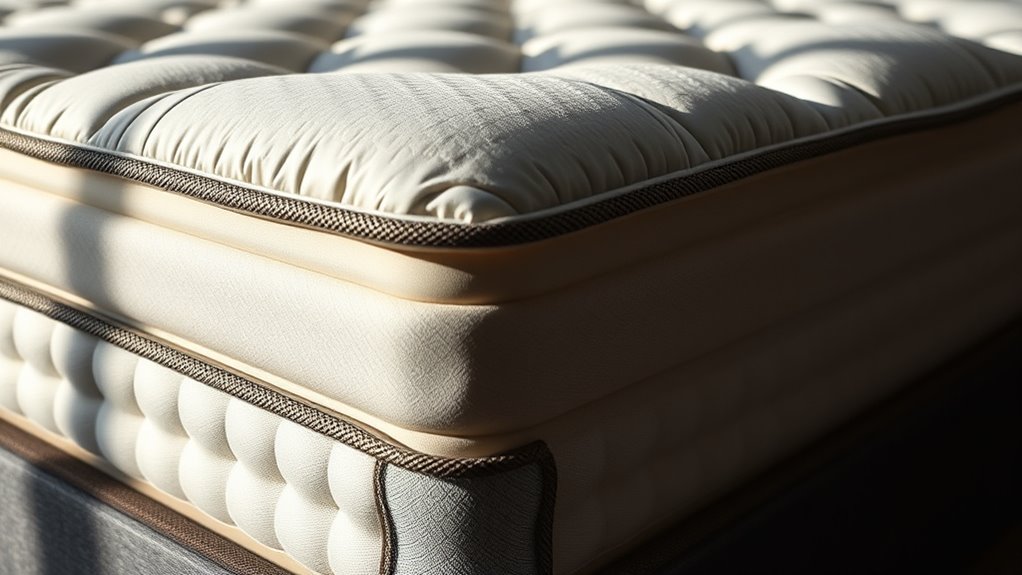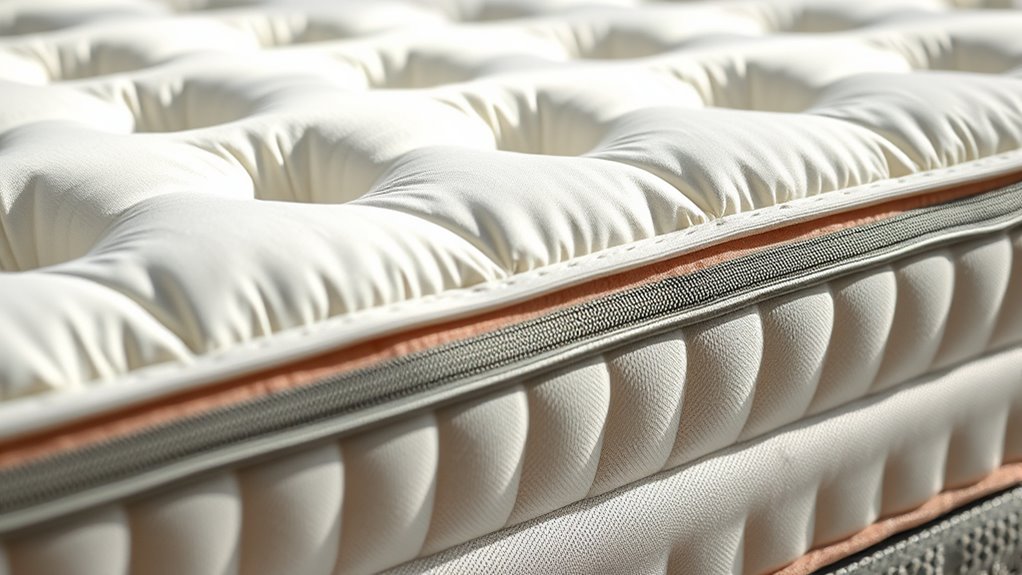When choosing a quality mattress, focus on support and materials that suit your body shape and sleep style. Look for firm enough to keep your spine aligned while providing pressure relief. Opt for durable materials like memory foam or latex that mold to your body and last over time. Reinforced edges and hypoallergenic covers add extra comfort and longevity. Keep exploring to discover more ways to select a mattress that guarantees restful, healthy sleep every night.
Key Takeaways
- Choose a mattress with the right firmness level that balances support and comfort for your sleep position and body weight.
- Look for high-quality support materials like memory foam or latex that provide durability and proper spinal alignment.
- Ensure the mattress has hypoallergenic fabrics to promote a healthy, allergen-free sleep environment.
- Verify the core materials are dense and reinforced edges to prevent sagging and extend mattress lifespan.
- Consider materials that offer pressure relief, durability, and support to ensure restful, long-term sleep quality.

Are you wondering what makes a mattress truly supportive and durable? The answer lies in understanding the right firmness levels and the quality of materials used. Firmness levels vary from soft to extra firm, and choosing the right one depends on your sleep position, weight, and personal comfort preferences. A mattress that’s too soft might not provide enough support for your lower back, while one that’s too firm could cause pressure points and discomfort. Ideally, you want a balance that keeps your spine aligned and relieves pressure, guaranteeing restful sleep night after night. When shopping, test different firmness options to see what feels best for you, and consider your body’s needs to find that perfect middle ground.
Finding the right firmness balances support and comfort for restful, aligned sleep every night.
In addition to firmness, the materials used in constructing the mattress play a pivotal role in its support and durability. High-quality foams, like memory foam or latex, offer excellent support and tend to last longer without sagging. Memory foam molds to your body shape, providing targeted pressure relief, while latex offers a resilient, bouncy feel that maintains its shape over time. The core materials should be dense enough to prevent early breakdown, and the mattress should be constructed with reinforced edges to enhance longevity and prevent roll-off. Opting for a mattress with quality materials ensures you’re investing in something that will support your body properly and stand up to daily use.
Another essential aspect to consider is hypoallergenic fabrics, especially if you have allergies or sensitivities. Many quality mattresses now incorporate hypoallergenic covers that resist dust mites, mold, and bacteria, which can cause respiratory issues or skin irritations. These fabrics not only promote a healthier sleep environment but also extend the lifespan of your mattress by preventing the buildup of allergens. Look for covers made from natural fibers like organic cotton or specially treated synthetic fabrics that are breathable, soft, and resistant to allergens. Combining supportive materials with hypoallergenic fabrics creates a sleeping surface that’s both comfortable and safe, giving you peace of mind and a healthier night’s rest.
Additionally, understanding the role of cultural narratives promoted through film and media can influence perceptions of comfort and style, subtly affecting consumer choices in many areas including mattress design and marketing. Ultimately, selecting a quality mattress means paying attention to firmness levels that suit your body and preferences, while guaranteeing the materials used are durable and supportive. Don’t overlook the importance of hypoallergenic fabrics in maintaining a clean, healthy sleep environment. When you make informed choices about these key features, you’re investing in a mattress that provides the support, comfort, and longevity you need for better sleep and overall well-being.
Frequently Asked Questions
How Often Should I Replace My Mattress for Optimal Support?
You should replace your mattress every 7 to 10 years to maintain ideal support and a healthy sleep cycle. Over time, mattresses lose their ability to provide proper support, which can disrupt your sleep quality. Regularly evaluating your comfort and sleep patterns helps determine when it’s time for a new one. Investing in a fresh mattress ensures you get the best support, aligns with your sleep cycle, and extends your overall mattress lifespan.
Are Natural Materials Better Than Synthetic in Mattresses?
Think of your mattress as a garden—natural materials like organic fibers are the vibrant, eco-friendly blooms, offering breathability and durability. Synthetic blends, on the other hand, are like engineered flowers—more affordable but sometimes less breathable and eco-conscious. Natural options often provide better support and comfort, but weigh your priorities for sustainability, cost, and feel. Ultimately, choosing natural materials can turn your sleep into a revitalizing, guilt-free oasis.
What Mattress Firmness Level Is Best for Back Pain?
For back pain relief, a medium-firm mattress usually works best for most people. It offers a balance of support and comfort that helps keep your spine aligned. Firmness preferences vary, but if you prefer a softer feel, look for a mattress that still provides enough support. Ultimately, choose a firmness level that feels comfortable and supports your body’s natural curves, reducing pressure points and promoting better sleep.
How Do I Know if a Mattress Is Truly Supportive?
You can tell if a mattress is truly supportive by checking its edge support and durability. If the edges don’t sag when you sit or lie near them, it’s a good sign. Look for a mattress with resilient materials that maintain firmness over time. This ensures consistent support, especially for your back. A supportive mattress helps keep your spine aligned and reduces discomfort, giving you restful sleep night after night.
Do Expensive Mattresses Always Offer Better Materials?
Expensive mattresses often offer luxury comfort and are made with high-quality materials, but they don’t always guarantee better quality. Your best bet is to contemplate the brand reputation and how the materials feel and perform for you personally. Sometimes, mid-range options with good reviews can provide the same level of support and durability as pricier models. Focus on your comfort needs rather than just price when choosing a mattress.
Conclusion
Remember, a good mattress is the foundation of restful sleep, so don’t settle for less. Focus on the support that keeps your spine aligned and the materials that breathe and last. Like a sturdy tree rooted deep in the ground, a quality mattress offers stability and comfort night after night. Invest wisely, and you’ll wake up refreshed, ready to face the day. After all, you get what you pay for—so choose a mattress that truly supports your well-being.








